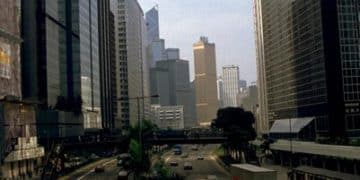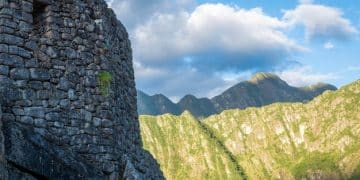Understanding Peruvian Currency: A US Tourist’s Financial Guide
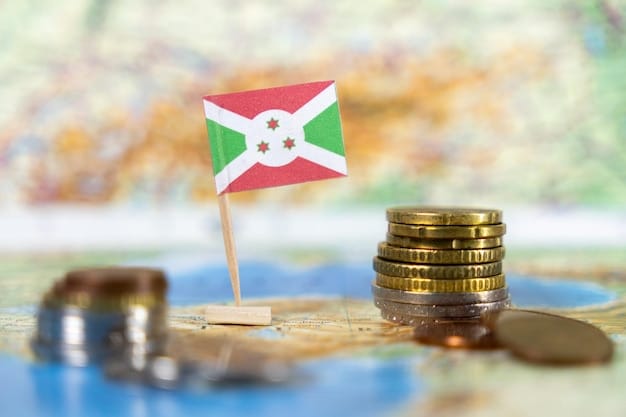
Understanding Peruvian currency is essential for US tourists to manage their finances effectively, ensuring smooth transactions and avoiding unexpected costs while exploring Peru’s rich culture and landscapes.
Planning a trip to Peru? Understanding Peruvian currency, the Sol (S/), is crucial for a smooth and budget-friendly experience. This guide provides US tourists with essential information to navigate Peruvian finances with confidence.
Understanding Peruvian Currency: The Basics for US Travelers
When traveling to Peru, familiarizing yourself with the local currency, the Sol (S/), is essential. Understanding its denominations, exchange rates, and how it’s used will help you manage your finances effectively and avoid confusion.
The Peruvian Sol is divided into 100 céntimos, similar to US dollars being divided into cents. Banknotes come in denominations of 10, 20, 50, 100, and 200 soles, while coins are available in 1, 2, and 5 soles, as well as 10, 20, and 50 céntimos.
Key Facts About the Peruvian Sol:
Here are some essential details about the Peruvian currency that every US tourist should know:
- Currency Symbol: S/
- Currency Code: PEN
- Subdivision: 1 Sol = 100 céntimos
- Banknotes: 10, 20, 50, 100, and 200 soles
- Coins: 1, 2, and 5 soles; 10, 20, and 50 céntimos
Knowing these facts will help you quickly identify and handle Peruvian currency, making transactions easier and more efficient.
It is also important to familiarize yourself with the look and feel of the banknotes to avoid counterfeit currency. The Banco Central de Reserva del Perú regularly updates the designs and security features of its currency to prevent forgery.
In conclusion, understanding the basic denominations and symbols of the Peruvian Sol is the first step to managing your finances in Peru. This knowledge will empower you to handle cash transactions with ease and confidence.
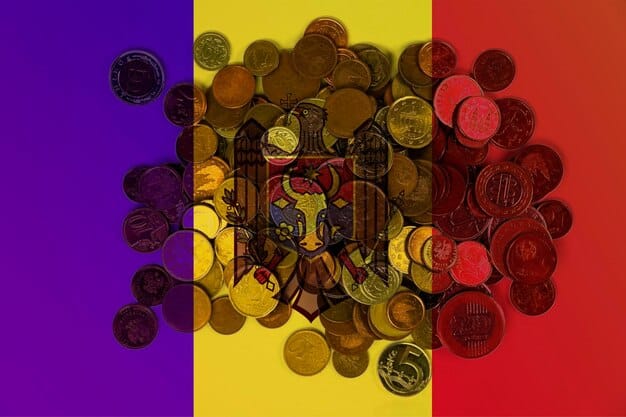
Exchanging US Dollars to Peruvian Soles: Where and How
One of the first things you’ll need to do upon arriving in Peru is to exchange your US dollars for Peruvian Soles. Knowing where and how to exchange your money can save you time and ensure you get a fair exchange rate.
There are several options for exchanging currency, each with its own advantages and disadvantages. Banks, exchange houses (casas de cambio), and ATMs are the most common choices for US tourists.
Best Places to Exchange Currency:
Here’s a breakdown of the best places to exchange USD to PEN:
- Banks: Generally offer competitive exchange rates but may require an account or charge transaction fees.
- Exchange Houses (Casas de Cambio): Found in airports, tourist areas, and city centers; they often provide better rates than banks but can vary widely, so it’s essential to compare.
- ATMs: Convenient for withdrawing soles directly from your US bank account, but be aware of potential foreign transaction fees and unfavorable exchange rates.
When exchanging currency, always compare the rates offered by different exchange houses. Look for the “compra” (buy) rate when selling USD and the “venta” (sell) rate when buying USD. Avoid exchanging money at airports, as they typically offer the worst exchange rates due to their convenience.
It’s also a good practice to exchange a small amount of currency before your trip to cover immediate expenses upon arrival, such as transportation and meals. However, avoid exchanging large sums of money at once, as exchange rates can fluctuate.
In summary, carefully consider your options when exchanging US dollars for Peruvian Soles, and compare rates to ensure you get the best deal. Opting for exchange houses in tourist areas or using ATMs can be more convenient and cost-effective than exchanging at airports or banks.
Using Credit and Debit Cards in Peru: What US Tourists Need to Know
While cash is widely used in Peru, credit and debit cards are also accepted in many establishments, especially in larger cities and tourist areas. Understanding how to use your cards and being aware of potential fees can help you manage your spending effectively.
Major credit cards like Visa and Mastercard are commonly accepted in hotels, restaurants, and larger stores. However, smaller businesses, markets, and street vendors often prefer cash. It’s always a good idea to carry some cash for smaller transactions.
Before traveling, notify your bank and credit card company about your trip to avoid having your card blocked due to suspected fraudulent activity. Also, inquire about any foreign transaction fees that may apply to your purchases or ATM withdrawals.
Tips for Using Credit and Debit Cards in Peru:
Here are some tips for using your cards in Peru:
- Inform Your Bank: Notify your bank about your travel dates to prevent your card from being blocked.
- Check for Fees: Be aware of foreign transaction fees charged by your bank or credit card company.
- Use ATMs Wisely: Opt for ATMs affiliated with reputable banks to minimize fees and security risks.
- Keep Cards Secure: Protect your cards from theft and fraud by keeping them in a safe place and monitoring your transactions regularly.
When using ATMs, be cautious of skimming devices and cover the keypad when entering your PIN. Choose ATMs inside banks during business hours for added security.
Additionally, consider using a credit card with no foreign transaction fees to save money on purchases. Some travel-specific credit cards offer this benefit, along with other perks like travel insurance and rewards points.
In conclusion, while credit and debit cards are convenient for larger purchases in Peru, it’s essential to be aware of fees and security risks. Notifying your bank, using ATMs wisely, and carrying some cash for smaller transactions will help you navigate your finances effectively.
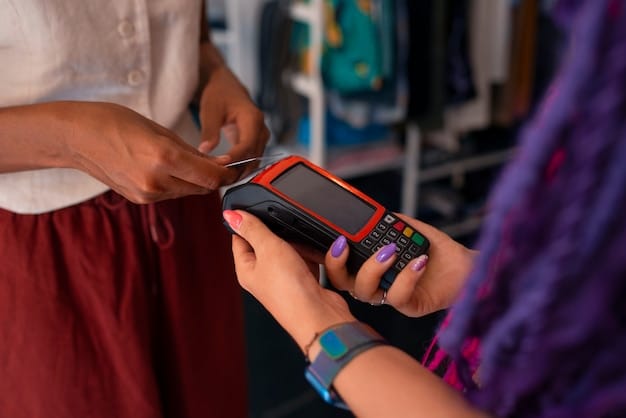
Budgeting Tips for US Tourists in Peru: Making Your Money Go Further
Effective budgeting is crucial for making the most of your trip to Peru. By setting a budget and tracking your expenses, you can enjoy your travel without overspending. Here are some practical tips to help US tourists stretch their dollars in Peru.
Start by estimating your daily expenses, including accommodation, food, transportation, activities, and souvenirs. Research the average cost of these items in the areas you plan to visit to create a realistic budget.
Accommodation can be a significant expense, so consider options like hostels, guesthouses, or Airbnb to save money. Eating at local markets and restaurants instead of tourist-oriented establishments can also significantly reduce your food costs.
Strategies for Saving Money in Peru:
Here are some detailed strategies for saving money while traveling in Peru:
- Travel During the Off-Season: Prices for accommodations and tours are often lower during the off-season (May to September).
- Use Public Transportation: Buses and colectivos (shared vans) are much cheaper than taxis or private transportation.
- Eat at Local Markets: Sample local cuisine at a fraction of the cost of tourist restaurants. Look for “menú del día” (daily menu) deals.
- Bargain Respectfully: Bargaining is common in markets and smaller shops. Be polite and offer a fair price.
Consider purchasing a tourist card if you plan to visit multiple attractions, as it can often offer discounted admission fees. Additionally, take advantage of free activities like walking tours and exploring local parks and markets.
Keep track of your spending by using a budgeting app or a simple spreadsheet. Regularly review your expenses to ensure you’re staying within your budget and make adjustments as needed. Be prepared for unexpected costs and set aside a contingency fund for emergencies.
In conclusion, by creating a budget, considering affordable accommodation and transportation options, and taking advantage of local markets and free activities, US tourists can make their money go further in Peru.
Tipping Etiquette in Peru: A Guide for US Visitors
Understanding tipping etiquette is an important aspect of navigating the cultural norms in Peru. While tipping is not as prevalent as in the United States, it is still customary in certain situations.
In restaurants, a service charge of 10% is often included in the bill. If the service charge is included, it is not necessary to leave an additional tip. However, if you receive exceptional service, you may choose to add a small tip on top of the service charge.
For other services, such as taxi drivers, tour guides, and hotel staff, tipping is generally appreciated but not mandatory. Use your discretion and tip based on the quality of service you receive.
When to Tip in Peru:
Here’s a quick guide on when and how much to tip in Peru:
- Restaurants: If a 10% service charge is included, no additional tip is required. If not included, a 10% tip is appreciated for good service.
- Taxi Drivers: Tipping is not customary, but you can round up the fare for good service.
- Tour Guides: A tip of 10-15% is appropriate for a guided tour, depending on the length and quality of the tour.
- Hotel Staff: Tip bellhops S/2-S/5 per bag and housekeeping staff S/5-S/10 per day.
When tipping, it is customary to hand the tip directly to the person providing the service. For tour guides, it is common to tip at the end of the tour, expressing your gratitude for the experience.
Keep in mind that while tipping is appreciated, it should not be seen as obligatory. If you are not satisfied with the service, you are not obligated to tip. However, if you receive exceptional service, a tip is a nice way to show your appreciation.
In conclusion, understanding tipping etiquette in Peru can help you navigate cultural norms and show appreciation for good service. While tipping is not always mandatory, it is often appreciated, especially in restaurants, hotels, and for tour guides.
Avoiding Scams and Financial Pitfalls in Peru
Like any popular tourist destination, Peru has its share of scams and financial pitfalls that US tourists should be aware of. Being vigilant and taking precautions can help you avoid becoming a victim of fraud.
One common scam involves counterfeit currency. Always examine banknotes carefully and be wary of accepting money from unofficial sources. Exchange currency only at reputable banks or exchange houses.
Another scam involves overcharging tourists for goods or services. Always agree on a price before accepting a service, such as a taxi ride or a tour. Be cautious of street vendors who may try to inflate prices for tourists.
How to Stay Safe from Scams:
Here are some practical tips to help you stay safe from scams and financial pitfalls in Peru:
- Use Reputable Services: Exchange currency only at banks or licensed exchange houses.
- Agree on Prices: Always agree on the price before accepting a service.
- Be Wary of Strangers: Be cautious of strangers offering unsolicited help or services.
- Protect Your Valuables: Keep your valuables in a safe place and avoid displaying expensive items.
Be cautious of ATMs, especially those in isolated areas. Use ATMs inside banks or during business hours for added security. Cover the keypad when entering your PIN and be aware of your surroundings.
If you encounter any suspicious activity or become a victim of a scam, report it to the local police. Keep a copy of your passport and credit card numbers in a safe place in case of theft.
In conclusion, being aware of common scams and taking precautions can help US tourists avoid financial pitfalls in Peru. Always use reputable services, agree on prices, and protect your valuables to ensure a safe and enjoyable trip.
| Key Point | Brief Description |
|---|---|
| 💰 Currency Basics | Understand denominations and symbols of the Peruvian Sol (S/). |
| 🏦 Exchanging USD | Compare rates at banks, exchange houses, and ATMs to get the best deal. |
| 💳 Card Usage | Inform your bank, check for fees, and use ATMs wisely to avoid issues. |
| ⚠️ Avoiding Scams | Use reputable services, agree on prices, and protect your valuables to stay safe. |
Frequently Asked Questions
The official currency of Peru is the Peruvian Sol, which is represented by the symbol S/. One Sol is divided into 100 céntimos. Banknotes come in denominations of 10, 20, 50, 100, and 200 soles, while coins are available in 1, 2, and 5 soles.
You can exchange US dollars for Peruvian Soles at banks, exchange houses (casas de cambio), and ATMs. Exchange houses often offer better rates than banks, but it’s important to compare rates before exchanging. Avoid exchanging money at airports, as they typically offer the worst exchange rates.
Yes, major credit cards like Visa and Mastercard are widely accepted in Peru, especially in larger cities and tourist areas. However, smaller businesses, markets, and street vendors often prefer cash, so it’s a good idea to carry some cash for smaller transactions.
In restaurants, a 10% service charge is often included in the bill. If not, a 10% tip is appreciated for good service. Tipping taxi drivers is not customary, but you can round up the fare. For tour guides, a tip of 10-15% is appropriate.
Common scams in Peru include counterfeit currency, overcharging tourists, and unsolicited help from strangers. Always exchange currency at reputable places, agree on prices before accepting services, and be cautious of strangers offering assistance.
Conclusion
Understanding Peruvian currency and financial practices is essential for US tourists to have a smooth and enjoyable trip. By familiarizing yourself with the Sol, exchanging currency wisely, using credit cards cautiously, and being aware of potential scams, you can manage your finances effectively and make the most of your Peruvian adventure.

